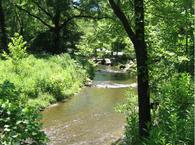
In cold water streams, sculpins are bottom feeding fish that are difficult to see. There are about 300 species of them, the largest of which grow to about two feet long. Most of them are found in shallow sea waters and others, such as the miller’s-thumb (Cottus gobio), inhabit freshwater. Among the freshwater sculpins, the Cottus genus is by far the most common and is found in the majority of the trout streams in the USA. They generally are a mottled brown in color and grow to about four inches long.
To develop the sculpin fly, sculpins were placed in aquariums so their behavior could be closely observed. As a result of this effort more about the movements and the behavior of the little bait fish were learned and incorporated into the design of the fly. As you may know, deer hair adds buoyancy to the fly. The head is spun deer hair and the beginning of the body is normal deer hair. Part of the body and the tail consist of feathers that look and move like the real thing.
The Perfect Fly Brown Sculpin was designed to be a realistic imitation of the sculpin’s appearance and also to mimic the movements as well as the behavior of the little fish. In the design process, it was tested with and without eyes, and with various weight combinations. As a result of this testing, a decision was made to use the red eyes, but not to add any weight to the fly. By adding the eyes, it is believed that it may be more attractive to the trout while not detracting from the effectiveness of the fly.
When trout observe the color red from a distance it appears to be brown, but as the trout gets closer, the red will indeed become redder in appearance. The color red is used effectively in many different types of fishing lures and there appears to be a valid reason for it. Weight has not been added to the fly for a variety of reasons. One reason is that the fly can be fished in very shallow waters. Under low light conditions, the brown trout are prone to get into the shallow water. If weight had been added, the fly would not be as effective in very shallow water.
Also, when weight was added internally on the hook, it had an adverse affect on the fly’s action and it did not swim as natural as the unweighted fly. Another reason for not adding weight is that a predetermined amount of weight does not work well for all conditions of water speed and depth. By not adding weight, the option is open to the angler to use weight as necessary. Sculpin stay right on the bottom, usually hidden down between the rocks on the stream’s bottom. They do move around on the bottom when they are feeding and that is when they are most likely to be eaten by a trout.
If the fly is weighted to the point it stays right on the bottom, the action is affected. When weight is added about 4 to 5 inches above the fly, it helps to increase the wiggle or natural swimming motion of the fly making it act just like the actual sculpin. It also keeps the sculpin in the feeding zone only about an inch or two above the bottom.





